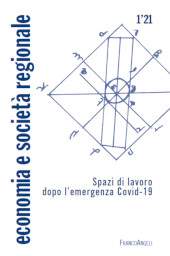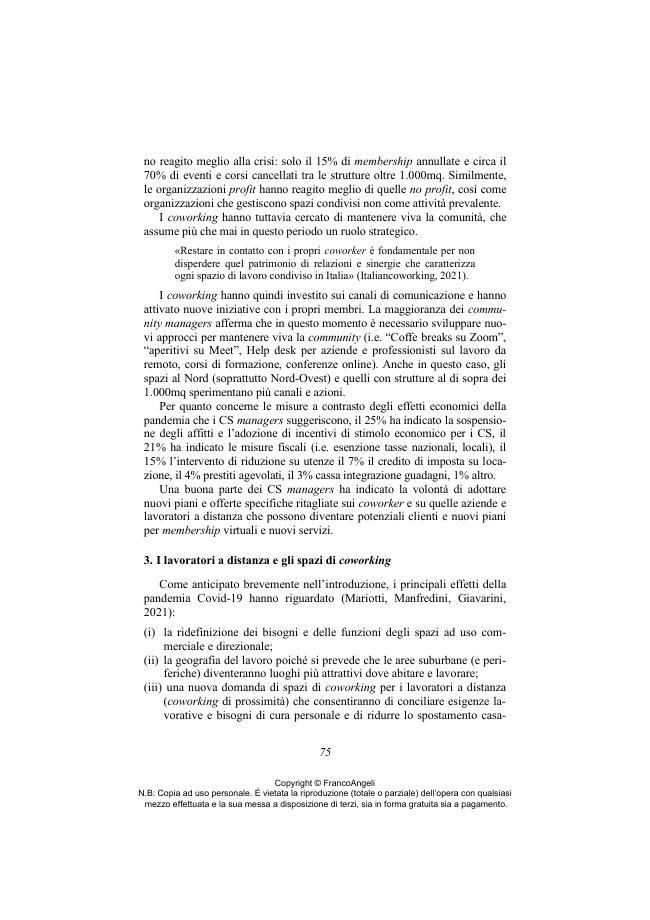2021 - Franco Angeli
Article
Digital Version
Download | Copy/paste | Printing
Gli spazi di coworking prima e durante la pandemia covid-19 : tipologie, geografia ed effetti
66-84 p.
- L'avvento del digitale ha contribuito all'aumento di alternative ai luoghi di lavoro tradizionali, quali ad esempio gli spazi di coworking, dove lavoratori autonomi e dipendenti, e piccole imprese possono avvantaggiarsi di interazione sociale e professionale al fine di ridurre i rischi di isolamento (in particolare nel caso di lavoro a domicilio) e aumentare le occasioni di incontro. La pandemia Covid19 ha avuto un impatto negativo sugli spazi di coworking: il 21,76% degli spazi nel mondo ha chiuso e il 71,67% ha registrato una significativa riduzione del numero di coworker che frequentano lo spazio, i quali hanno iniziato a lavorare a domicilio. In Italia il numero di coworking chiusi nei mesi di marzo e aprile ammonta al 59,15%, mentre il 36,62% è aperto ad attività essenziali. Durante la pandemia, il numero dei lavoratori a distanza e a domicilio è significativamente aumentato e il coworking di prossimità può rappresentare un valido luogo di lavoro.
- Il presente contributo si inserisce in questo contesto e si propone di descrivere le tipologie, la geografia e i principali effetti dei nuovi luoghi del lavoro prima e durante la pandemia Covid19, con attenzione al caso italiano. [Testo dell'editore].
- Digital advancements have contributed to the rise of alternative solutions to traditional workplaces, such as coworking spaces, where selfemployed workers, startups and small businesses can take advantage of social and professional interactions; to reduce the risks of isolation (particularly in the case of home working) and increase meeting opportunities. The Covid19 pandemic has had negative impacts on coworking spaces: 21.76% of spaces in the world are closed, and 71.67% recorded a significant reduction in the number of users. In Italy, 59.15% of coworking spaces were closed in March and April 2020, while 36.62% of spaces remained open to essential activities. During the pandemic, the number of remote and home workers increased significantly, and the "proximity coworking" can represent an efficient workplace.
- Within this context, the current contribution aims to describe the typologies, geography, and main effects of the new workplaces pre and during the pandemic, with a specific focus on the case of Italy. [Publisher's text].
Is part of
Economia e società regionale : 1, 2021-
Information
ISSN: 2038-6745
KEYWORDS
- Spazi di coworking, effetti, geografia, tipologie, pandemia Covid-19
- Coworking Spaces, Effects, Geography, Typologies, Covid-19 pandemic
-
In this issue
- Spazi di lavoro dopo l'emergenza covid-19 : introduzione al tema
- Plusvalore geografico, (cyber)spazio e lavoro
- Il lavoro agile fuori dalla straordinarietà : appunti sulla contrattazione collettiva
- Lavoro agile tra rottura del vincolo spaziale e ricerca di una nuova dimensione del luogo di lavoro
- Lavorare da casa, lavorare in casa
- Gli spazi di coworking prima e durante la pandemia covid-19 : tipologie, geografia ed effetti
- Gli spazi collaborativi in emilia-romagna : caratteristiche e ripresa post covid
- La didattica a distanza durante la pandemia di covid-19 : il lavoro dei docenti e la diversità dei contesti scolastici
- Università fra digitalizzazione e territori : sfide e opportunità per l'internazionalizzazione dopo la pandemia
- Sindacato e lavoro agile dopo la pandemia : intervista a Giuliano Guietti, Ires Emilia Romagna
- La classe operaia va nel cyberspazio : il capitalismo di piattaforma oltre i miti della digitalizzazione
- Performance ambientale nel distretto della concia di arzignano : tra iniziativa imprenditoriale e intervento istituzionale
- Idee in discussione



